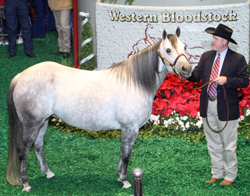 In any other horse arena, results of the 2008 NCHA Futurity Sales would be good news. Compared to recent years, however, the sales average was down 36 percent overall, not surprising in light of the all encompassing economic crisis.
In any other horse arena, results of the 2008 NCHA Futurity Sales would be good news. Compared to recent years, however, the sales average was down 36 percent overall, not surprising in light of the all encompassing economic crisis.
“The cutting horse market and the global economy are what they are due to factors that none of us can control,” said Jim Ware, president and director of marketing for Western Bloodstock, which has produced the NCHA Futurity Sales for the past nine years. “The only thing we can control is how we react to the changes and what we do for the future.”
International growth and increase in purses has made cutting the fastest growing segment of the show horse industry. So it is interesting to compare the results of the 2008 sales with those of previous years.
“To me the annual chart that we produce tells the story of what is going on in the market,” said Ware. “It shows the ups and downs over the nine years that Western Bloodstock has been producing the NCHA sales. We have sold record high horses in every category. Will the market go back up? You bet. It always does. And there are things people can do in the meantime.
“This is the perfect time to buy quality mares and breed them to good stallions. Quality always wins. It doesn’t necessarily mean the horse that’s won the most money. Quality is a well-bred horse that has performed well and that is a good-looking individual. People are always in the market for a pretty, well-bred horse.”
Ware pointed out that in the crash of the late 1980s and early 1990s, many people benefitted from the purchase of well-bred mares, which increased in value after purchase and produced top show prospects. Buyers currently have similar opportunities, but they should be discerning and purchase wisely.
“This is also a good time for people to learn more about these horses in general, so that they can improve their stock,” Ware noted. “I’m not talking about “magic crosses,” that you see written about. There is no such thing as a magic cross. But it’s a fact that knowledgeable breeders produce quality because they know good horses and they understand how to raise and manage them.
“We don’t want to stop breeding horses, because we need good horses to compete with. But there are too many average horses and we can do something about that, by breeding wisely and caring properly for the babies, when they are developing.”
In the short and long term, Ware is excited about the cutting horse industry. “People will continue to cut because they love it,” he said. “The bottom line is that they do it because they love it.
“Our business is like the art world – it’s a matter of what people can afford at the time. The NCHA is going to keep putting on good cuttings and Western Bloodstock is going to conform to market demands and keep putting on good sales.”
Here’s a recap of the past nine years of Western Bloodstock NCHA Futurity Sales:
| 2004 | 2005 | 2006 | 2007 | 2008 | |
| Lots Offered | 1434 | 1315 | 1125 | 1250 | 1440 |
| Lots Sold | 1086 | 1017 | 940 | 1029 | 1120 |
| Completed Sales | 75% | 77% | 84% | 82% | 77% |
| Actual Average | $18,030 | $17,490 | $21,370 | $21,082 | $13,688 |
| Top 10 Average | $277,000 | $207,700 | $267,000 | $336,500 | $200,000 |
| Top 20 Average | $194,550 | $150,900 | $195,450 | $238,850 | $149,700 |
| Top 100 Average | $78,850 | $69,155 | $88,740 | $94,590 | $66,035 |
| Top 200 Average | $55,732 | $48,950 | $60,845 | $64,160 | $44,845 |
|
|
|||||
| 2000 | 2001 | 2002 | 2003 | ||
| Lots Offered | 930 | 765 | 1364 | 1268 | |
| Lots Sold | 770 | 613 | 1050 | 963 | |
| Completed Sales | 82% | 80% | 77% | 75% | |
| Actual Average | $15,300 | $21,343 | $14,813 | $17,130 | |
| Top 10 Average | $239,500 | $343,600 | $207,200 | $235,700 | |
| Top 20 Average | $156,000 | $222,250 | $147,300 | $171,950 | |
| Top 100 Average | $61,000 | $77,098 | $66,595 | $74,842 | |
| Top 200 Average | $40,000 | $49,165 | $45,699 | $50,961 | |
